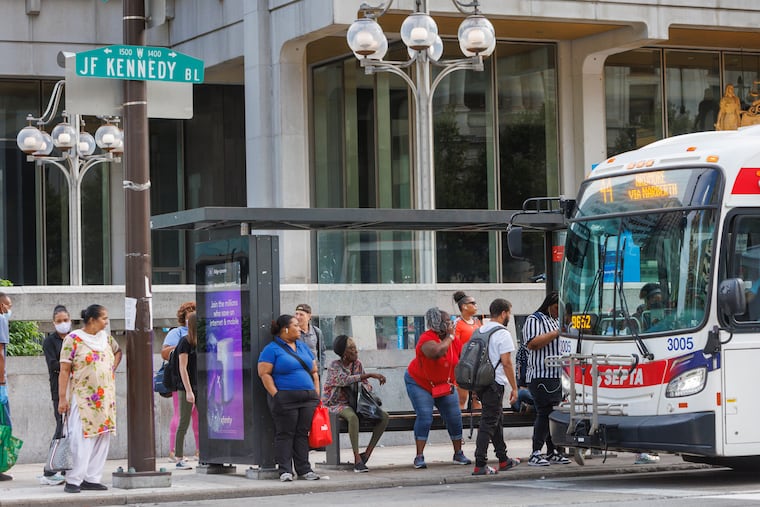Philadelphia’s Black workers spend 34 more minutes per week commuting than white workers, new report says
"It means less time with your family, less time doing the things you would rather be doing,” one of the report's co-authors said. “You can’t get back time.”

Black Philadelphians spend more time getting to and from work than their white counterparts, and the pandemic may have widened the gap, according to a new report from researchers at the Federal Reserve Bank of Philadelphia.
Across the U.S., Black workers have longer commutes than white workers by a difference of 5%, the report said. But the difference is larger in the Philadelphia region: 11%.
Researchers said the difference is “substantial.”
“It means less time with your family, less time doing the things you would rather be doing,” said Nassir Holden, who co-authored the report. “You can’t get back time.”
Holden and co-author Christopher Severen noted that the difference between Black and white commutes has decreased in the past 40 years. Still, on average, Philadelphia’s Black workers spend 34 more minutes per week commuting than white workers, as of 2019.
The report uses data from the U.S. Census Bureau from 2012 to 2019. The researchers didn’t use data from the past three years because the COVID-19 pandemic altered commuting patterns, and many workers are likely still adjusting to new hybrid and remote arrangements, the report said.
However, the data remains relevant, Severen said, because the same issues exist now and may be even worse. “Many of the factors that were going on were exacerbated by the pandemic,” he said.
Black workers and low-income workers were more likely to be taking transit — which saw service reductions because of the pandemic and isn’t yet back to pre-pandemic service levels — and white workers are more likely to be able to work from home, Holden and Severen said.
The researchers found that where people live and how they get to work — driving, walking or transit — were important factors in determining commute differences by race. However, they noted, even when comparing riders of the same mode, commutes were longer for Black workers than white workers.
“This trend is worrying because it could represent reduced equity in transit services,” the report said.
Inequality that ‘changes pretty slowly’
While a worker’s method of getting to work plays a role in commute length, Severen emphasized that converting all commuters to car drivers wouldn’t solve the problem.
Even among car users alone, Black drivers’ commutes were about 11% longer than white drivers. When looking at bus and subway alone, the difference between white and Black commute times has increased since 1980, the report said.
The researchers pointed to other factors that may have contributed to the difference in commute times over a period of decades, including where people live, where jobs are located and how people in power prioritize transportation investments.
“Philly has long been a segregated city and that changes pretty slowly,” Severen said.
At the same time, jobs have been moving to the suburbs.
In 1980, 35% of Greater Philadelphia workers had jobs in the city, but that had dropped to 24% by 2019. Moving jobs to the suburbs hurts Black employment prospects, the report said, because Black households are less likely to move to the suburbs.
That may mean reverse-commuting for those who choose to live in the city while working in the suburbs. While that’s not bad in itself, Severen said, public transportation isn’t built to serve reverse-commuters. Those commutes are more difficult without a car, making those jobs less accessible to low-income workers.
More transit, more riders
The researchers also pointed to transit investment in the region, saying it “may itself perpetuate patterns of inequality.”
For example, the report said, SEPTA’s suburb-serving Regional Rail got 38% of the transportation authority’s capital outlays from 2007 to 2016, while supporting 11% of ridership. The subway got 21% of capital outlays during those years, while supporting 28% of ridership.
“A policy itself may not be particularly racist, but if a marginalized group can’t grasp the benefits of a policy, that just exacerbates what they’re already feeling,” Holden said.
SEPTA spokesperson Andrew Busch said “SEPTA has made equity and accessibility core values in everything it does, from fare policy to improvement projects.” He cited new fare policies enacted during the pandemic and capital improvements meant to improve accessibility for people with disabilities on the Broad Street Line and Market-Frankford Line.
The report noted that decreased ridership on public transportation has led to service cuts in large cities throughout the U.S. In the Philadelphia area, SEPTA still isn’t back to 100% of pre-COVID service levels, and has been struggling with staffing shortages amid a gravely uncertain financial future.
“To continue this progress, SEPTA needs help from its state and local funding partners,” Busch said. “We are hopeful that the state and region will make public transportation a priority so SEPTA can continue with efforts to build a more equitable and accessible system.”
The researchers declined to make specific policy recommendations based on their findings. But, broadly, they said improving access to high-quality transportation is important for worker welfare everywhere, including robust schedules.
“Transit frequency is a driver of demand,” Severn said. “Frequency begets ridership.”